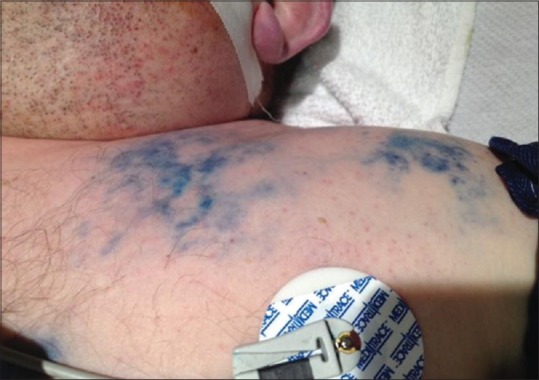Abstract
The authors present an image of a middle-aged male after coronary artery bypass grafting who received intravenous methylene blue for refractory hypotension that resulted in dermal tattooing/staining of the venous vasculature of his left shoulder and left upper chest.
Republished with permission from: Bhatt AM, Tripathi RS, Moran KR, Papadimos TJ. Dermal tattooing following intravenous methylene blue for refractory hypotension after coronary artery bypass grafting. OPUS 12 Scientist 2012;6(1):11.
Keywords: Complication, coronary artery bypass grafting, dermal tattooing, methylene blue, refractory hypotension
CASE PRESENTATION
A 48-year-old male, 5 feet 8 inches in height and 100 kg in weight, arrived in the Cardiovascular Intensive Care Unit (CVICU) after receiving three-vessel coronary artery bypass grafting. He arrived in the CVICU on infusions of epinephrine and norepinephrine. His systolic blood pressure remained less than 70 mmHg, and he was not responsive to the above-mentioned infusions or to the addition of a vasopressin infusion and fluid challenges. He subsequently received methylene blue (MB) intravenously, dosed at 2 mg/kg and administered over 30 minutes. The dermal tattooing/staining pattern occurred within 30 min of the termination of the MB bolus [Figure 1]. The patient's hypotensive state was corrected. The MB staining resolved within 48 h.
Figure 1.

Dermal tattooing of the left shoulder and left upper chest after methylene blue infusion
This patient had a normal to high cardiac output, a low normal central venous pressure, and low systemic vascular resistance. His systemic inflammatory response may be attributed to his cardiopulmonary bypass run. Such a circumstance is normally referred to as vasoplegic syndrome (VS) – an endothelial dysfunction considered to be secondary to direct and indirect effects of multiple inflammatory mediators.[1] The use of MB, an inhibitor of nitric oxide synthase and guanylate cyclase, has demonstrated improvement of refractory hypotension in VS.[1,2]
MB has diverse uses. While its use in methemoglobinemia is well known, and its effective use in postcardiopulmonary bypass VS is becoming more substantive, its application in septic shock, hepatopulmonary syndrome, malaria, ifosfamide neurotoxicity, neutralization of heparin, use in high flow priapism, and in Alzheimer's disease will need more prospective confirmation.[3]
The complication reported here could have occurred because of vasodilation and leakage of intravascular fluid or damage to the vasculature secondary to manipulation perioperatively and resultant extravasation. It could also involve lymph vessel delineation. While mild skin discoloration has been reported with intravenous use of MB postcardiac surgery,[4] as well as its recognition as a vital stain taken up by tissues that absorb actively, such as the colon and small intestine and its use in sentinel node/lymphatic vessel mapping,[5] a dramatic dermatographic-like clinical presentation described herein remains rare.
Financial support and sponsorship
Nil.
Conflicts of interest
There are no conflicts of interest.
Acknowledgments
Justifications for republishing this scholarly content include (a) the phasing out of the original publication – the OPUS 12 Scientist and (b) wider dissemination of the research outcome(s) and the associated scientific knowledge.
This scholarly work was conducted in accordance with the ethical principles set forth in the Declaration of Helsinki. Patient consent was obtained before the submission of this manuscript.
REFERENCES
- 1.Stawicki SP, Sims C, Sarani B, Grossman MD, Gracias VH. Methylene blue and vasoplegia: Who, when, and how? Mini Rev Med Chem. 2008;8:472–90. doi: 10.2174/138955708784223477. [DOI] [PubMed] [Google Scholar]
- 2.Wisler JR, Stawicki SPA. Hemodialysis - Different Aspects, Prof. Maria Goretti Penido. Rijeka, Croatia: InTech; 2011. Methylene Blue and Dialysis-Related Hypotension; pp. 45–58. [Google Scholar]
- 3.Ginimuge PR, Jyothi SD. Methylene blue: Revisited. J Anaesthesiol Clin Pharmacol. 2010;26:517–20. [PMC free article] [PubMed] [Google Scholar]
- 4.Ozal E, Kuralay E, Yildirim V, Kilic S, Bolcal C, Kücükarslan N, et al. Preoperative methylene blue administration in patients at high risk for vasoplegic syndrome during cardiac surgery. Ann Thorac Surg. 2005;79:1615–9. doi: 10.1016/j.athoracsur.2004.10.038. [DOI] [PubMed] [Google Scholar]
- 5.Canto MI. Staining in gastrointestinal endoscopy: The basics. Endoscopy. 1999;31:479–86. doi: 10.1055/s-1999-8041. [DOI] [PubMed] [Google Scholar]


